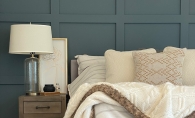It’s that time of year when the top of many New Year’s resolution lists reads: Get Organized . . . For real this time. And DeeDee Welles, owner of Details Organizing It All, is just the gal to help you do it.
Because organizing is one of those tasks we’d prefer to avoid, Welles suggests enlisting the help of a professional organizer to recognize the most common pitfalls we face when we aspire to get organized but can’t. These key factors range from emotions involved with letting items go to analyzing how we work best in our homes to identifying personal goals and recognizing what phase of life we are in. They all play a role.
Once these topics are addressed, an organizer can help create a space and environment that reflects our schedule, habits and day-to-day activities, to give our homes and offices that sense of order, functionality and, most of all, peace that we crave.
“People mistake getting organized with buying organizational things,” Welles says. “But when you have too much stuff, just putting it in bins is not organizing.”
How It All Began
For many years, Welles worked for nonprofits and private schools doing event planning and fundraising before starting her own business. For her, organizing has always come naturally. “Most organizers will tell you they’re born with the organizing gene,” she laughs.
Her focus eventually shifted from doing large events to helping people one-on-one. “People knew I was good at organizing, and they were always needing help and asking for advice. I liked the idea of working with people on a smaller scale.” For the last four years, Welles has helped folks in the seven-county metro area get organized. “It’s really fun meeting all different kinds of people, and going into their homes and small businesses and helping them out.”
The Process
Welles’ projects vary based on the needs of her client, but her approach during the first session always remains the same. “The fundamental thing is learning what the clients’ goals are, and then trying to keep them in the forefront of their mind,” she says. “What can happen is you start going through stuff and then there is a story behind it.”
This happens especially when Welles works with baby boomers who have transitioned out of their careers and raising kids, and find themselves in a different phase of life. “You’re not entertaining as much, not having businesspeople over, or [accommodating] tons of family, kids and teenagers. You’ve acquired all this stuff over the years and now you don’t want it or need it anymore. So most people over 50 are trying to downsize and not have so much,” Welles explains.
Often, Welles says, memories of certain items can sidetrack a client, or there is an emotional attachment to personal belongings that makes it hard to get rid of the object. “People may want to turn a room into an office, but often they’ll lose the plot in terms of their goal. I keep them on task by reminding them what their goal is.”
The Finished Product
Amy DeLong of Vadnais Heights reached out to Welles when the clutter in her office prohibited her from successfully running her business from home. “I needed help getting started,” DeLong recalls. “[The office] needed help for probably the last five years. I was wasting too much energy working around the messes.”
The first time Welles and DeLong got together for hands-on organizing, Welles listened and asked helpful questions throughout their session, including, “Are you going to use this every day?” or “When was the last time you used this?” These questions helped the two develop a system for organizing the space that would work best for DeLong.
The first time she and Welles tackled the office it took three hours, and DeLong even continued to do six more hours of work afterwards. “She took the overwhelm out of [the project] by setting up the systems,” the business owner recalls. “She’d say, ‘Now you do a, b and c, and when these are done, we can get together again.’ It motivated me and gave me a plan to do something, otherwise I was [completely overwhelmed].”
She worked with Welles for several sessions, and there are still a few odds and ends that have to be tied up, but she is amazed at the progress they’ve made. “I walked away going, ‘Oh, my gosh, this feels so good!’ “When the office itself is not a to-do list, it’s a lot easier to focus on your actual work,” DeLong laughs.
How Much Does it Cost?
Welles offers packages designed with a variety of organizing needs in mind. “The Starter” ($290) is a four-hour session to put a big dent in whatever obstacle you currently face. “Seize the Day” ($540) is the next price point, which provides two sessions (eight hours) to incorporate personal systems to help streamline your life and workflow. Other packages include services to create a “life documents archive” ($1,180), and the “Inner Peace” package ($2,990), gives you all the benefits of the previous packages and the time to tackle the whole house.
Get Organized and Stay That Way
- Start small. You don’t have to organize your home in a day; getting started is huge.
- Use waiting time—if waiting for water to boil, clean out a silverware drawer.
- Use a timer, set for 15 minutes, and go!
- Be kind to yourself. Becoming organized is a process, so let go of the high expectations.
- Use a reward system: when finishing a small project, get an ice cream cone, see a movie, etc.
- Stay in the present and keep coming back to your overall goal.
- Ask yourself: Is it worth keeping? Is it worth the emotional cost of keeping and maintaining it? If I’m going to keep it, where will it go?
- Check your impulse decisions when you see something you “must have” at the store.









